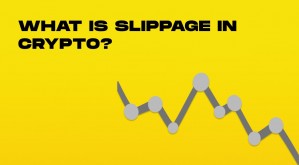What Is Slippage in Cryptocurrency Trading?
Slippage is the difference between the expected price of a trade and the actual executed price. In simpler terms, it’s when you end up buying higher or selling lower than you intended.
For example, if you place an order to buy Bitcoin at $50,000, but by the time your transaction processes, the price has moved to $50,200, you’ve experienced a 0.4% slippage.
Why Does Slippage Happen?
Slippage isn’t a glitch or an error – it’s a natural part of trading in volatile markets. Here are the main causes:
Market fluctuations can cause significant differences between the expected and actual executed prices of trades.
1. Market Volatility
Cryptocurrency markets can experience wild price swings in seconds due to rapid price fluctuations. High volatility means prices change rapidly between when you submit an order and when it actually executes.
2. Low Liquidity
When there aren’t enough buyers and sellers in a market (low liquidity), even small trades can cause significant price movements. This is especially common with:
-
Smaller altcoins
-
New token launches
-
During off-peak trading hours
Trading on platforms with high liquidity can significantly reduce slippage by ensuring a larger volume of transactions.
3. Large Order Sizes
Trying to buy or sell a large amount of cryptocurrency at once can "eat through" the available orders in the order book, resulting in progressively worse prices as your order fills.
Positive vs. Negative Slippage
Not all slippage is bad news. There are two types:
| Type | Description | Impact |
|---|---|---|
| Positive Slippage | When execution price is better than expected | You pay less when buying or receive more when selling |
| Negative Slippage | When execution price is worse than expected | You pay more when buying or receive less when selling |
Most traders are concerned with negative slippage, which directly costs you money.
How Slippage Impacts Your Trading
Slippage can have several effects on your trading:
-
Reduced profitability - Even small percentage slippage adds up over multiple trades
-
Failed transactions - If slippage exceeds your tolerance settings, orders may not execute at all
-
Strategy disruption - Precise entry and exit points become difficult to achieve
Effective management of slippage is crucial for improving overall trading outcomes.
Managing Slippage: Practical Solutions
You can’t eliminate slippage entirely, but you can reduce slippage by implementing the following strategies:
1. Set Slippage Tolerance
Most decentralized exchanges (DEXs) allow you to set slippage tolerance – the maximum percentage difference you’ll accept between expected and actual execution price. Slippage occurs when there is a difference between the expected price and the actual executed price of a trade.
For major cryptocurrencies in normal conditions, 0.5-1% is often sufficient. For smaller tokens or volatile conditions, you might need 2-5% or higher.
2. Use Limit Orders Instead of Market Orders
Market orders execute immediately at whatever the current price is, making them vulnerable to slippage. Limit orders only execute at your specified price or better, ensuring trades occur at a specific price – though they may not fill if the market moves away from your price.
3. Trade During Higher Liquidity Periods
Avoid trading during major news events or at times when trading volume is historically low. Higher liquidity generally means less slippage. Trading during a highly volatile market can lead to increased slippage due to rapid price changes.
4. Break Up Large Orders
Instead of executing one large trade, consider splitting it into smaller chunks to minimize market impact. Large orders can lead to substantial slippage as they consume available liquidity in the order book.
5. Choose Exchanges With Deep Liquidity
Major exchanges typically have more trading volume and tighter spreads, reducing potential slippage. Centralized platforms typically offer deeper liquidity, reducing the risk of slippage.
Warning Signs: When to Be Extra Cautious
Be especially vigilant about slippage under these conditions:
-
When trading newly launched tokens
-
During extreme market volatility (bull or bear runs)
-
When trading on decentralized exchanges with low liquidity
-
If you’re making large trades relative to the trading volume
-
During times of network congestion, transactions can be delayed, leading to increased slippage
Real-World Examples of Slippage
Example 1: High-Volatility Slippage
During a market crash characterized by extreme volatility, you try to sell 1 ETH at $2,000. By the time your transaction processes (seconds later), the price has dropped to $1,940. You’ve experienced 3% negative slippage.
Example 2: Low-Liquidity Slippage
A trader places an order to buy $5,000 worth of a new altcoin with a small market cap. The expected price is $1 per token, but your order executes at an average of $1.15 per token, resulting in 15% slippage due to limited sell orders in the book.
Slippage FAQs
Is slippage the same as fees?
No. Fees are fixed costs charged by exchanges for processing your transactions. Slippage is the price difference caused by market movements during transaction processing. Slippage is an inherent risk of trading, unlike fixed fees charged by exchanges.
Why do DEXs have more slippage than centralized exchanges?
Decentralized platforms (DEXs) typically have lower liquidity and rely on automated market makers rather than traditional order books, which can result in higher slippage, especially for less popular trading pairs.
What happens if I set my slippage tolerance too low?
Your transaction may fail to execute and get rejected. You'll typically still pay gas fees (on networks like Ethereum) despite the failed transaction.
Can slippage be predicted?
While you can’t predict exact slippage, unexpected price changes can make it difficult to estimate potential slippage accurately. However, you can still estimate potential slippage by looking at factors like market volatility, trading volume, and order book depth before placing a trade.
The Bottom Line
Slippage is an unavoidable aspect of crypto trading, especially in volatile or illiquid markets. By understanding why it happens and implementing strategies to manage slippage, you can protect your trades from excessive price differences.
Remember that finding the right balance is key – setting slippage tolerance too low might cause failed transactions, while setting it too high could result in unfavorable execution prices. As you gain more trading experience, you’ll develop a better feel for appropriate slippage settings across different market conditions.
























